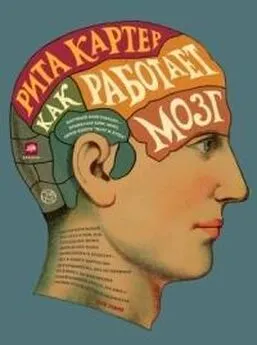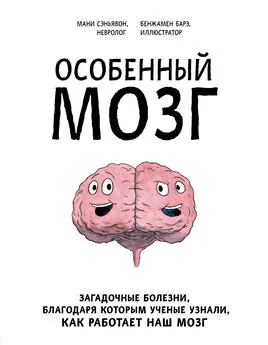Дин Бернетт - Счастливый мозг. Как работает мозг и откуда берется счастье
- Название:Счастливый мозг. Как работает мозг и откуда берется счастье
- Автор:
- Жанр:
- Издательство:Эксмо
- Год:2018
- Город:Москва
- ISBN:978-5-04-095041-6
- Рейтинг:
- Избранное:Добавить в избранное
-
Отзывы:
-
Ваша оценка:
Дин Бернетт - Счастливый мозг. Как работает мозг и откуда берется счастье краткое содержание
Счастливый мозг. Как работает мозг и откуда берется счастье - читать онлайн бесплатно ознакомительный отрывок
Интервал:
Закладка:
124
Elliot, A.J. and M. V. Covington, Approach and avoidance motivation. Educational Psychology Review, 2001. 13 (2): p. 73–92.
125
Cofer, C.N., The history of the concept of motivation. Journal of the History of the Behavioral Sciences, 1981. 17 (1): p. 48–53.
126
Lee, W., et al., Neural differences between intrinsic reasons for doing versus extrinsic reasons for doing: An fMRI study. Neuroscience Research, 2012. 73 (1): p. 68–72.
127
Benabou, R. and J. Tirole, Intrinsic and extrinsic motivation. The review of economic studies, 2003. 70 (3): p. 489–520.
128
Lepper, M.R., D. Greene, and R. E. Nisbett, Undermining children’s intrinsic interest with extrinsic reward: A test of the “overjustification” hypothesis. Journal of Personality and Social Psychology, 1973. 28 (1): p. 129–137.
129
Lapierre, S., L. Bouffard, and E. Bastin, Personal goals and subjective well-being in later life. The International Journal of Aging and Human Development, 1997. 45 (4): p. 287–303.
130
Agnew, R., Foundation for a general strain theory of crime and delinquency. Criminology, 1992. 30 (1): p. 47–88.
131
Higgins, E.T., et al., Ideal versus ought predilections for approach and avoidance distinct self-regulatory systems. Journal of personality and social psychology, 1994. 66 (2): p. 276.
132
Leonard, N.H., L. L. Beauvais, and R. W. Scholl, Work motivation: The incorporation of self-concept-based processes. Human relations, 1999. 52 (8): p. 969–998.
133
Neal, D.T., W. Wood, and A. Drolet, How do people adhere to goals when willpower is low? The profits (and pitfalls) of strong habits. Journal of Personality and Social Psychology, 2013. 104 (6): p. 959.
134
Bem, D.J., Self-perception: An alternative interpretation of cognitive dissonance phenomena. Psychological review, 1967. 74 (3): p. 183.
135
Utevsky, A.V. and M. L. Platt, Status and the Brain. PLoS Biology, 2014. 12 (9): p. e1001941.
136
Pezzulo, G., et al., The principles of goal-directed decision-making: from neural mechanisms to computation and robotics. 2014, The Royal Society.
137
Leung, B.K. and B. W. Balleine, The Ventral Striato-Pallidal Pathway Mediates the Effect of Predictive Learning on Choice between Goal-Directed Actions. The Journal of Neuroscience, 2013. 33 (34): p. 13848.
138
Media, O. Home | Nuffield Farming Scholarships Trust. 2017; Available from: http://www.nuffieldscholar.org/.
139
Miron-Shatz, T., ‘Am I Going to Be Happy and Financially Stable?’ How American Women Feel When They Think about Financial Security. 2009.
140
Moesgaard, S. How Money Affects the Brain’s Reward System (Why Money is Addictive). 2013 2013–03–21; Available from: http://reflectd.co/2013/03/21/how-money-affects-the-brain/.
141
Hyman, S.E. and R. C. Malenka, Addiction and the brain: the neurobiology of compulsion and its persistence. Nature reviews. Neuroscience, 2001. 2 (10): p. 695.
142
Sharot, T., The optimism bias: A tour of the irrationally positive brain. 2011: Vintage.
143
Howell, et al., Money buys financial security and psychological need satisfaction: Testing need theory in affluence.
144
Holmes, T., Rahe R. Holmes-Rahe life changes scale.
145
Saarni, C., The development of emotional competence. 1999: Guilford Press.
146
Rodriguez, T., Negative Emotions Are Key to Well-Being, Scientific American. 2013, Tori Rodriguez.
147
Adkins, A., U. S. Employee Engagement Steady in June. 2016, GALLUP.
148
André Spicer, C.C., The Research We’ve Ignored About Happiness at Work. 2015, Harvard Business Review.
149
Van Kleef, G.A., C. K. De Dreu, and A. S. Manstead, The interpersonal effects of anger and happiness in negotiations. Journal of personality and social psychology, 2004. 86 (1): p. 57–76.
150
Ferguson, D., The world’s happiest jobs. 2015, @guardian.
151
Peralta, C.F. and M. F. Saldanha, Can dealing with emotional exhaustion lead to enhanced happiness? The roles of planning and social support. Work & Stress, 2017. 31 (2): p. 121–144.
152
Mauss, I.B., et al., The pursuit of happiness can be lonely. Emotion, 2012. 12 (5): p. 908.
153
Theeuwes, J., Top – down and bottom – up control of visual selection. Acta Psychologica, 2010. 135 (2): p. 77–99.
154
LoBue, V., et al., What accounts for the rapid detection of threat? Evidence for an advantage in perceptual and behavioral responding from eye movements. Emotion, 2014. 14 (4): p. 816–23.
155
Jabbi, M., J. Bastiaansen, and C. Keysers, A Common Anterior Insula Representation of Disgust Observation, Experience and Imagination Shows Divergent Functional Connectivity Pathways. PLOS ONE, 2008. 3 (8): p. e2939.
156
Clarke, D., Circulation and energy metabolism of the brain. Basic neurochemistry: molecular, cellular and medical aspects, 1999: p. 637–669.
157
Miller, G., The mating mind: How sexual choice shaped the evolution of human nature. 2011: Anchor.
158
Dunbar, R.I., The social brain hypothesis and its implications for social evolution. Ann Hum Biol, 2009. 36 (5): p. 562–72.
159
Flinn, M.V., D. C. Geary, and C. V. Ward, Ecological dominance, social competition, and coalitionary arms races: Why humans evolved extraordinary intelligence. Evolution and Human Behavior, 2005. 26 (1): p. 10–46.
160
Reader, S.M. and K. N. Laland, Social intelligence, innovation, and enhanced brain size in primates. Proceedings of the National Academy of Sciences of the United States of America, 2002. 99 (7): p. 4436–4441.
161
Spradbery, J.P., Wasps. An account of the biology and natural history of social and solitary wasps, with particular reference to those of the British Isles. 1973.
162
Gavrilets, S., Human origins and the transition from promiscuity to pair-bonding. Proceedings of the National Academy of Sciences of the United States of America, 2012. 109 (25): p. 9923–9928.
163
West, R.J., The evolution of large brain size in birds is related to social, not genetic, monogamy. Biological journal of the Linnean Society, 2014. 111 (3): p. 668–678.
164
Bales, K.L., et al., Neural correlates of pair-bonding in a monogamous primate. Brain Research, 2007. 1184: p. 245–253.
165
Dunbar, R.I.M. and S. Shultz, Evolution in the social brain. science, 2007. 317 (5843): p. 1344–1347.
166
Pasquaretta, C., et al., Social networks in primates: smart and tolerant species have more efficient networks. Scientific reports, 2014. 4: p. 7600.
167
Van Gestel, S. and C. Van Broeckhoven, Genetics of personality: are we making progress? Molecular psychiatry, 2003. 8 (10): p. 840–852.
168
Matsuzawa, T., Evolution of the brain and social behavior in chimpanzees. Current Opinion in Neurobiology, 2013. 23 (3): p. 443–449.
169
Gunaydin, Lisa A., et al., Natural Neural Projection Dynamics Underlying Social Behavior. Cell. 157 (7): p. 1535–1551.
170
Gardner, E.L., Introduction: Addiction and Brain Reward and Anti-Reward Pathways. Advances in psychosomatic medicine, 2011. 30: p. 22–60.
171
Loken, L.S., et al., Coding of pleasant touch by unmyelinated afferents in humans. Nat Neurosci, 2009. 12 (5): p. 547–548.
172
Iggo, A., Cutaneous mechanoreceptors with afferent C fibres. The Journal of physiology, 1960. 152 (2): p. 337–353.
173
Insular cortex – Wikipedia. 2017; Available from: https://en.wikipedia.org/wiki/Insular_cortex.
174
Kalueff, A.V., J. L. La Porte, and C. L. Bergner, Neurobiology of grooming behavior. 2010: Cambridge University Press.
175
Claxton, G., Why can’t we tickle ourselves? Perceptual and Motor Skills, 1975. 41 (1): p. 335–338.
176
Keverne, E.B., N. D. Martensz, and B. Tuite, Beta-endorphin concentrations in cerebrospinal fluid of monkeys are influenced by grooming relationships. Psychoneuroendocrinology, 1989. 14 (1): p. 155–161.
177
Gispen, W.H., et al., Modulation of ACTH-induced grooming by [DES-TYR1] -γ-endorphin and haloperidol. European Journal of Pharmacology, 1980. 63 (2): p. 203–207.
178
Dumbar, R., Co-Evolution of neocortex size, group size and language inhumans. Behavioral and Brain Sciences, 1993. 16 (4): p. 681–735.
179
Dunbar, R. and R.I.M. Dunbar, Grooming, gossip, and the evolution of language. 1998: Harvard University Press.
180
Crusco, A.H. and C. G. Wetzel, The Midas Touch. Personality and Social Psychology Bulletin, 1984. 10 (4): p. 512–517.
181
Dumas, G., et al., Inter-Brain Synchronization during Social Interaction. PLOS ONE, 2010. 5 (8): p. e12166.
182
Livingstone, M.S. and D. H. Hubel, Anatomy and physiology of a color system in the primate visual cortex. Journal of Neuroscience, 1984. 4 (1): p. 309–356.
183
Rizzolatti, G., et al., 14 From mirror neurons to imitation: facts and speculations. The imitative mind: Development, evolution, and brain bases, 2002. 6: p. 247–266.
184
Wicker, B., et al., Both of Us Disgusted in My Insula. Neuron, 2003. 40 (3): p. 655–664.
185
Schulte-Rüther, M., et al., Mirror Neuron and Theory of Mind Mechanisms Involved in Face-to-Face Interactions: A Functional Magnetic Resonance Imaging Approach to Empathy. Journal of Cognitive Neuroscience, 2007. 19 (8): p. 1354–1372.
186
Shamay-Tsoory, S.G., J. Aharon-Peretz, and D. Perry, Two systems for empathy: a double dissociation between emotional and cognitive empathy in inferior frontal gyrus versus ventromedial prefrontal lesions. Brain, 2009. 132 (3): p. 617–627.
187
de Waal, F.B.M., Apes know what others believe. Science, 2016. 354 (6308): p. 39.
188
Brink, T.T., et al., The Role of Orbitofrontal Cortex in Processing Empathy Stories in 4- to 8-Year-Old Children. Frontiers in Psychology, 2011. 2: p. 80.
189
Hall, F.S., Social deprivation of neonatal, adolescent, and adult rats has distinct neurochemical and behavioral consequences. Critical Reviews™ in Neurobiology, 1998. 12 (1–2).
Читать дальшеИнтервал:
Закладка:










